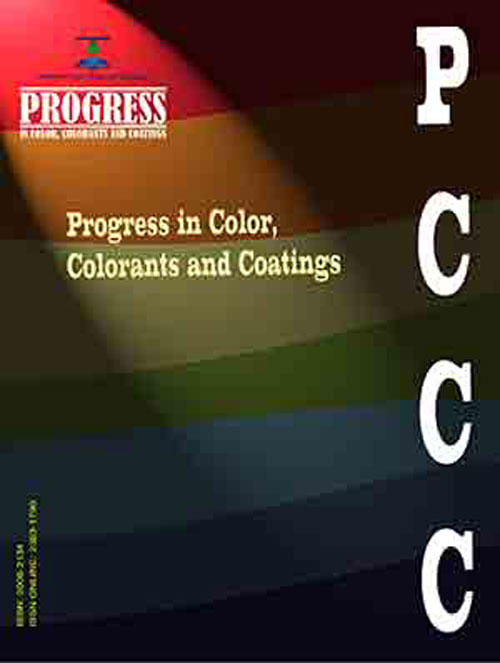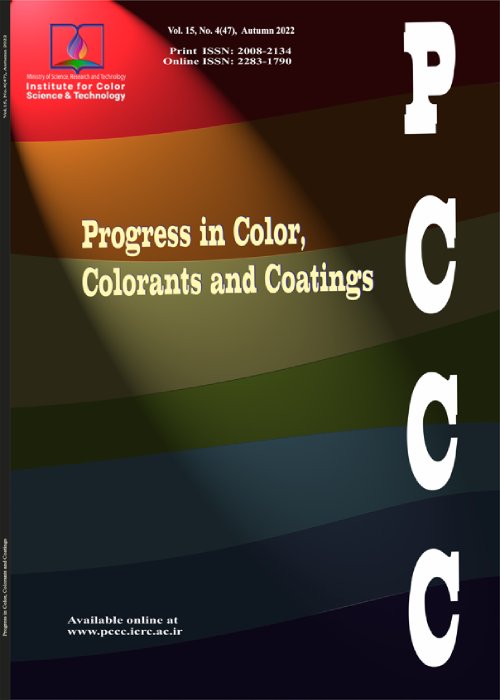فهرست مطالب

Progress in Color, Colorants and Coatings
Volume:11 Issue: 2, Spring 2018
- تاریخ انتشار: 1397/02/20
- تعداد عناوین: 6
-
-
Page 69In this study, four arylazobenzylidene dyes (a-d) were synthesized with excellent yields in two steps using Knoevenagel condensation and azo-coupling reactions. Absorption spectra of these dyes with different substituents were investigated in organic solvents as a function of solvent polarity. The spectral features of synthesized arylazobenzylidene dyes were described according to azo-hydrazone tautomerism as well as the solvatochromic characteristic of the approved tautomer. The nature and degree of solute-solvent interactions were illustrated using Kamlet-Taft multi-parameter polarity scales. The effects of acid-base on the UV-visible absorption spectra of the dyes were reported. In addition, different absorption characteristics were observed for these dyes in pure diethanolamine.Keywords: Arylazobenzylidene dye, Solvatochromism, Tautomerism, Substituent effect
-
Page 79An ecological approach has been obtained by using natural dyes and mordant for dyeing process. Fabrics dyed using myrobalan extract as natural mordants and green dye. A red color were obtained by using theses mordants. The color of dyed fabrics was investigated in CIELab L, a and b and K/S values. Finally, all dyed fabrics were tested for wash and light fastness properties as per ISO standard test methods. The results of using biomordants for fabrics dyeing were comparable with that of the metallic mordants in terms of color strength and fastness properties. myrobalan extract as biomordants produced red color with medium fastness properties and thus offer full potential to replace metal salts in dyeing process.Keywords: Natural dyeing, Myrobalan, Biomordant, Extraction, Fastness
-
Page 85In this work, zinc ferrite magnetic and zinc ferrite-graphene oxide nanocomposite were synthesized through a facile hydrothermal method and dye removal capability as an adsorbent were studied. Fourier transform infrared spectroscopy FT-IR, X-ray diffraction XRD and scanning electron microscopy SEM were used to characterize the synthesized nanocomposite. The UV-Vis results showed that the addition of as-prepared magnetic nanoparticles on the graphene oxide sheets significantly improved the adsorption of organic dye pollutants from aqueous solution. Magnetic hysteresis measurements were done on a vibrant sample magnetometer VSM viewing the soft paramagnetic property of the resulting products at room temperature. The structural and morphological analyses were also studied in detail. The adsorption kinetics was described by pseudo-second-order model. Because zinc ferrite-graphene oxide nanocomposite could be recycled suitably and possessed of adsorptive property, it can be developed as an inexpensive and alternative adsorbent to treat dye wastewater.Keywords: Zinc Ferrite, nanocomposite, Synthesis, Dye removal, Kinetic
-
Page 93This study is aimed at evaluating the performance of tetrakismethylene-3-3,5-di-tert-butyl-4-hydroxyphenyl propionate methane S1010, tris2,4-di-tert-butylphenyl phosphite S1680 and ascorbic acid AA antioxidants in stabilization of hydroxypropyl cellulose HPC. For this purpose, a number of films with weight percent ratios of 0.4 w/w were prepared in a 1 isopropanol solution w/v. Then, the films underwent accelerated aging processes at the 3 light UV; 216hr, dry-heat 120°C; 240 hr and moist-heat 70°C; RH: 95; 240 hr conditions. During the aging processes, structural changes were studied using the attenuated total reflectance Fourier transform infrared ATR-FTIR spectroscopy and based on the defined destruction indices. In addition, changes in color of films were evaluated by colorimetry in CIELab system before and after the aging process. According to the obtained results, the S1010 phenolic antioxidant led to improvements in color and structure stabilization of HPC against environmental destructing factors in all three destruction processes of photooxidation, thermooxidation and hydrothermal.Keywords: Polymer degradation, Hydroxypropyl cellulose (HPC), Oxidation, Antioxidant, ATR-FTIR
-
Page 103Polysulfide is well known elastomer for use in aerospace applications due to providing flexible coating and chemically resistant sealants. In this work, the effects of carbon black content on curing behavior of polysulfide elastomer were investigated and Rheological properties for samples with different filler content 15, 20 and 25 phr were evaluated by rheometric mechanical spectrometer RMS. According to RMS analysis, sample with 20 phr carbon black had minimum gel point temperature and loss factor and highest elasticity. Also, the time sweep test for the optimal sample resulted from temperature and frequency sweep at 90°C was done and gel time obtained less than a few minutes. From the dynamic differential scanning calorimetry DSC diagram for polysulfide with 20 phr carbon black observed two exothermic peaks in heat flow for uncured sample. The first peak indicated the curing of polysulfide elastomer and second peak may be attributed the curing of resole resin and formation of methylene linkage.Keywords: Polysulfide elastomer, Carbon black, Rheological properties, Cure behavior
-
Page 113In this paper the effect of whiteness attribute of white substrates on blackness property of black coated fabrics is investigated. To this aim, four cotton fabrics with different whiteness and tint attributes are used as white substrates. To prepare a set of black samples, various concentrations of four color pigments, i.e., red, green, blue and yellow, were mixed with the black one and applied on white fabrics via the routine textile printing method. Then, the colorimetric attributes of black coated fabrics prepared by applying of the same recipes on different white substrates were investigated. The results indicate to the effect of substrates whiteness index and tint factor on colorimetric characteristics of achieved blacks where by decreasing of the whiteness attribute of white substrates the black coated fabrics became darker and more saturated. Besides, depends on the colorimetric attributes of employed white substrate, the tint attributes of black coated fabrics differ, dramatically. As a summary, the general imagination of dominance effect of blackness rather than the whiteness attribute of employed white substrate is not approved.Keywords: Textile printing, black coated fabrics, tint attribute, white substrate


